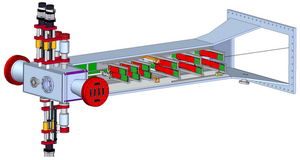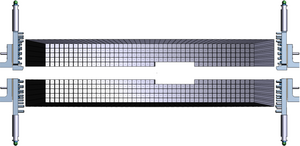The HPS Run Wiki
[edit]
Phone NumbersShift ScheduleShift-Taker's ChecklistHot CheckoutBeam Time AccountingRun Spreadsheet 2019,2016, 2015HPS Upgrade ERRCOO, ESAD, RSAD Things to read before shift. |
Procedures
|
Manuals |
JLab Logbooks
|
HPS 2019 run, June X to August Y'
Beam energy 4.5 GeV
Important: Document all your work in the logbook!
Bluejeans for Run Meetings on DAY and DAY at 2pm
RC: Stepan Stepanyan
- (757) 575-7540
- 9 575 7540 from Counting Room
PDL: Valery Kubarovsky
- (757) 876-1789
- 9 876-1789 from Counting Room
* !! Chicane magnets can be energized only when the hall is in Beam Permit, [1]. Chicane magnets must be off if the hall is in Restricted or in Controlled access.
* The vacuum gauge used in SVT interlock (2H03) is broken. Watch the gauge 2H02, in case of a vacuum event valves will close and the beam will be shut-off. If the event is at 2H02 (loss of vacuum near HPS chamber) call SVT expert immediately and follow his/her instruction.
|
Run Plan June 17 - 18, 2019When beam is back
Follow "General Guidelines" on the right and the Beamline Procedures.
Important Notes:
|
General InstructionsDAQ RECOVERYIf DAQ crashed/broken:
Establishing Physics Quality Beam for HPS:
Note: in order to have reliable readings on two important for HPS BPMs, 2H00 and 2H02, beam current should be >30 nA.
Setting up the FSD threshold
hpsrun@clonpc11> /home/hpsrun/scripts/FSD/Calc_FSD_Threshold.exe
|
Every Shift:
|
Every Run:
|
|---|
RC daily meetings at 2 pm in the counting-house 2nd-floor conference room.
BlueJeans Info:
URL: https://bluejeans.com/794825703
Meeting ID: 794825703
|
|
| ||||||||||||||||||||||||||||||||||||||||||||||||||||||||||||||||||||||||||||||||||||||||
|
Webcams:
|
Accelerator:
|
Slow Controls:
|
Online & Offline: |
| System/Person | Pager/Phone Number |
|---|---|
| Run Coordinator | (757) 575-7540 (cell) |
| Physics Div. Liaison | (757) 876-1789 (cell) |
| MCC-OPS | 7048 |
| Crew Chief | 7045 |
| Crew Chief | 9-879-3367 (cell) |
| Program Deputy | 9-876-7997 (cell) |
| Gate House Guard | 5822 |
| DAQ/Online | (757) 869-2188 (cell) |
| SVT | (757) 310-7198 (cell) |
| ECAL | (757) 810-1489 (cell) |
| Slow Controls | (757) 748-6922 (cell) |
| Beamline | (757) 303-3996 (cell) |
| Engineering | (757) 748-5048 |
| Hall-B Floor | 5165 |
| Hall-B Space Frame | 5170, 5171 |
| Hall-B Forward Carriage | 5371 |
| Hall-B Counting Room | 5126, 5244, 5246, 5247 |
| Hall-B Gas Shed | 7115 |

